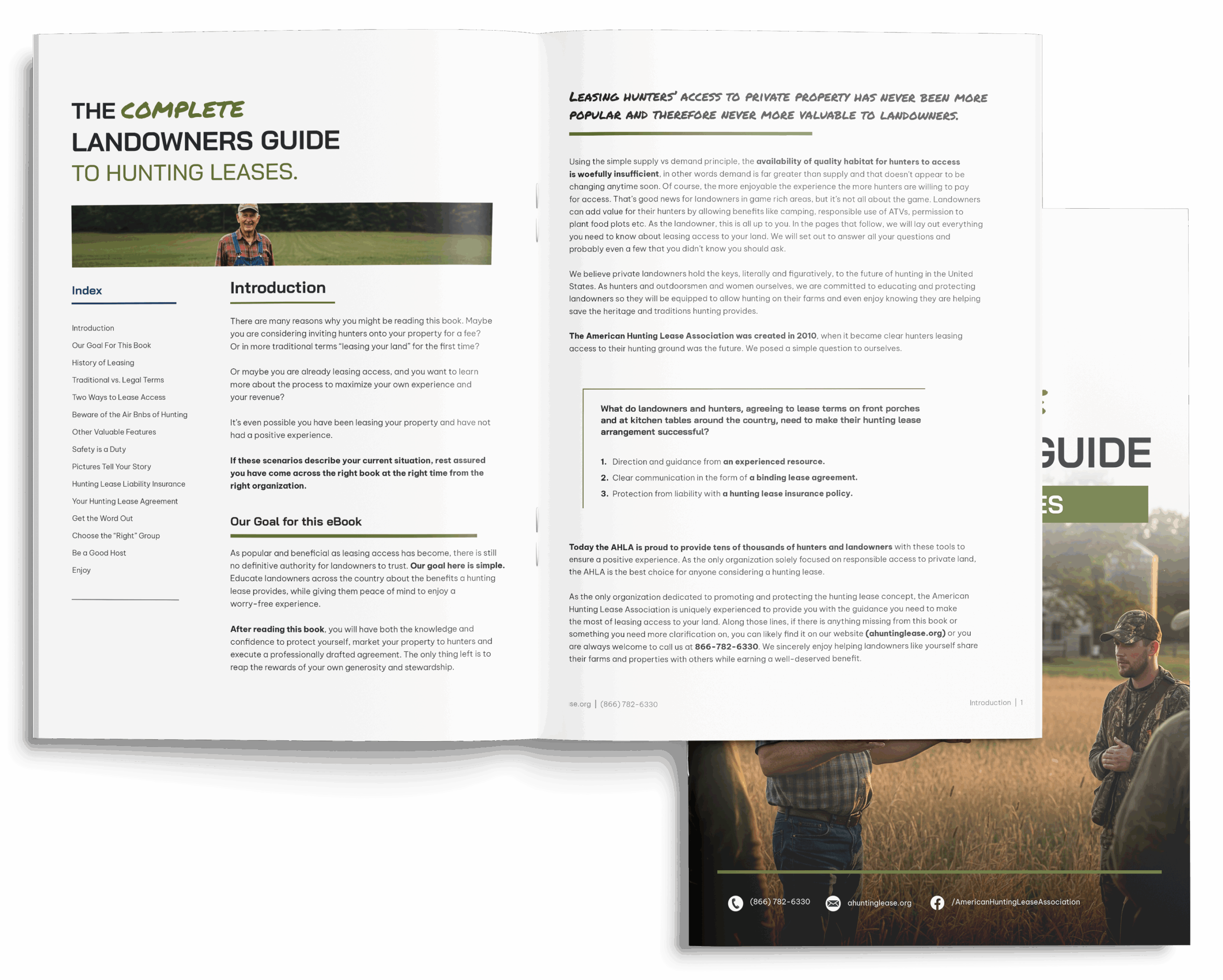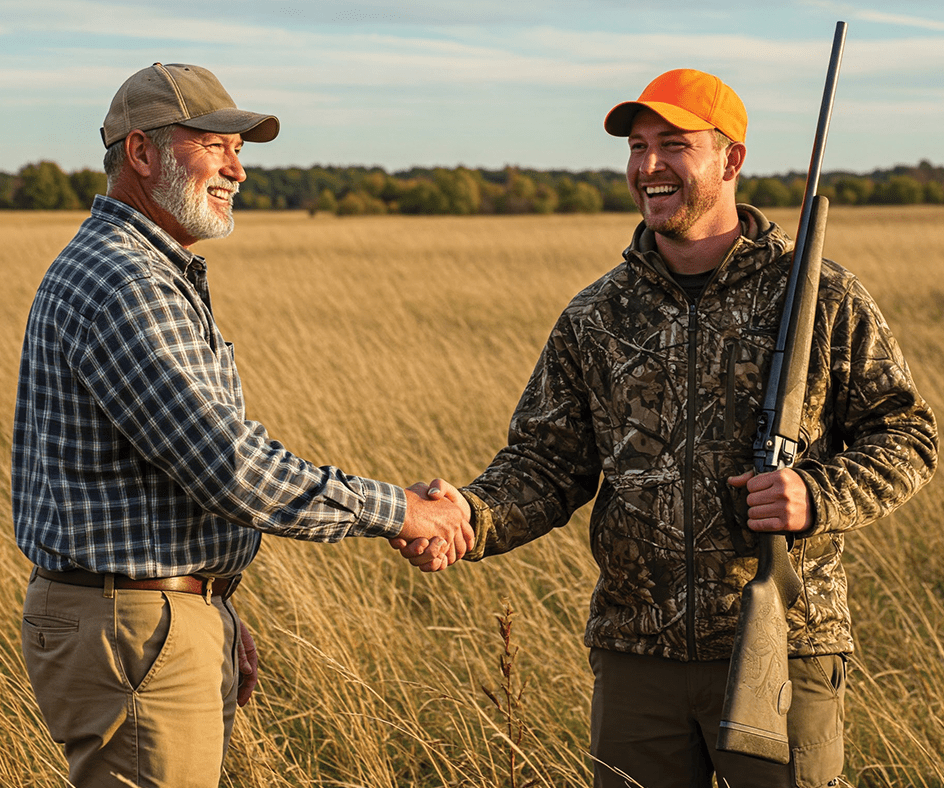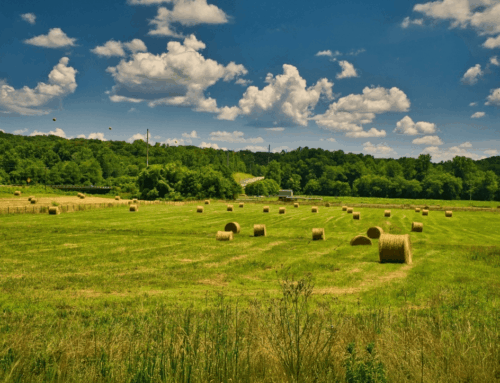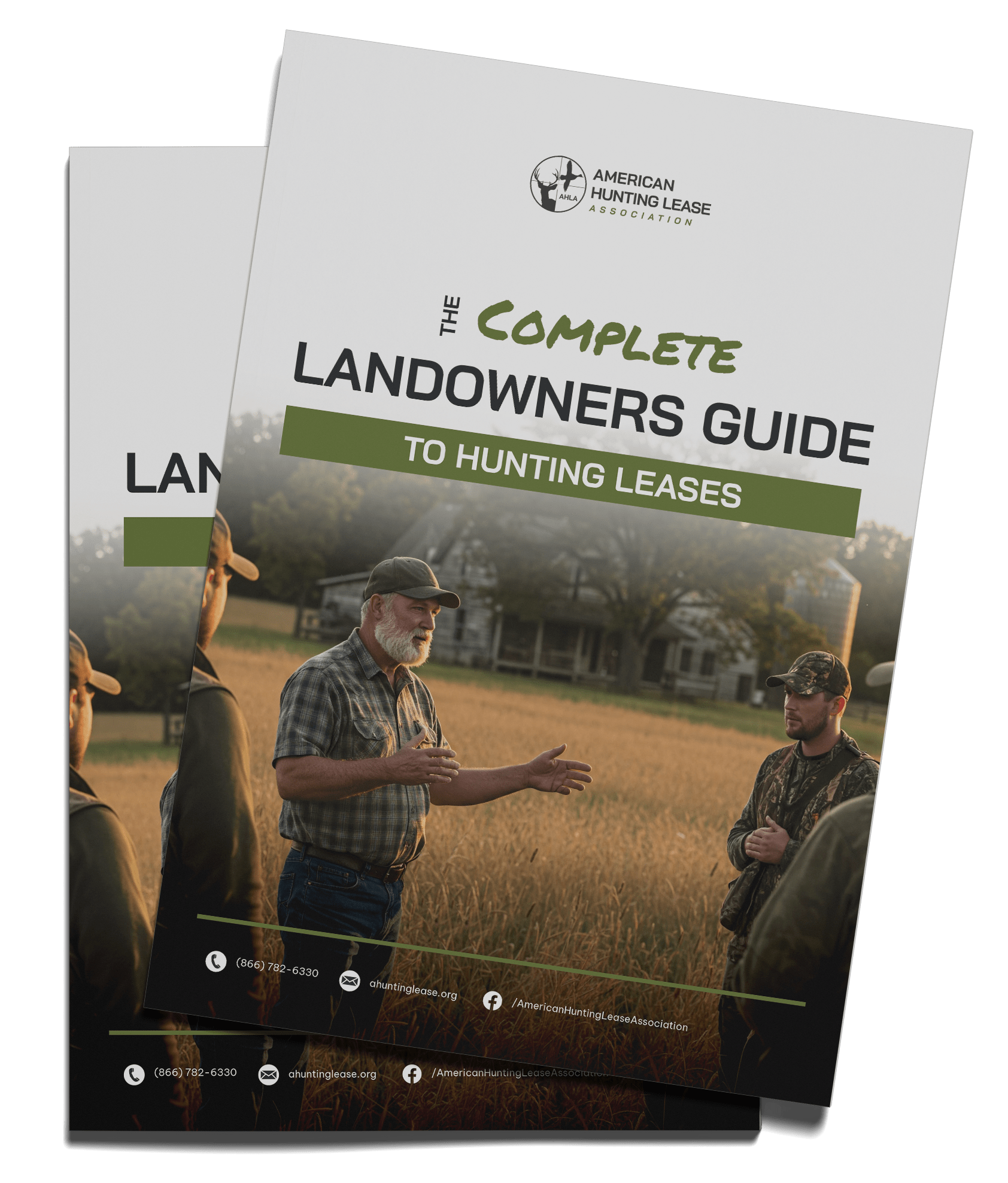
Introduction: There are many reasons why you might be reading this book. Maybe you are considering inviting hunters onto your property for a fee? Or in more traditional terms “leasing your land” for the first time? Or maybe you are already leasing access, and you want to learn more about the process to maximize your own experience and your revenue?
It’s even possible you have been leasing your property and have not had a positive experience. If these scenarios describe your current situation, rest assured you have come across the right book at the right time from the right organization.
Our Goal For This eBook
As popular and beneficial as leasing access has become, there is still no definitive authority for landowners to trust. Our goal here is simple. Educate landowners across the country about the benefits a hunting lease provides, while giving them peace of mind to enjoy a worry-free experience.
After reading this book, you will have both the knowledge and confidence to protect yourself, market your property to hunters and execute a professionally drafted agreement. The only thing left is to reap the rewards of your own generosity and stewardship.
Using the simple supply vs demand principle, the availability of quality habitat for hunters to access is woefully insufficient, in other words demand is far greater than supply and that doesn’t appear to be changing anytime soon. Of course, the more enjoyable the experience the more they are willing to pay for access. That’s good news for landowners in game rich areas, but it’s not all about the game.
Landowners can add value for their hunters by allowing benefits like camping, responsible use of ATVs, permission to plant food plots etc. As the landowner, this is all up to you. In the pages that follow, we will lay out everything you need to know about leasing access to your land. We will set out to answer all your questions and probably even a few that you didn’t know you should ask.
We believe landowners hold the keys, literally and figuratively, to the future of hunting in the United States. As hunters and outdoorsmen and women ourselves, we are committed to educating and protecting landowners so they will be equipped to allow hunting on their farms and even enjoy knowing they are helping save the heritage and traditions hunting provides.
The American Hunting Lease Association was created in 2010, when it became clear hunters leasing access to their hunting ground was the future. We posed a simple question to ourselves.

Today the AHLA is proud to provide tens of thousands of hunters and landowners with these tools to ensure a positive experience. As the only organization solely focused on responsible access to private land, the AHLA is the best choice for anyone considering a hunting lease.
As the only organization dedicated to promoting and protecting the hunting lease concept, the American Hunting Lease Association is uniquely experienced to provide you with the guidance you need to make the most of leasing access to your land. Along those lines, if there is anything missing from this book or something you need more clarification on, you can likely find it on our website (ahuntinglease.org) or you are always welcome to call us at (866) 782-6330. We sincerely enjoy helping landowners like yourself share their farms and properties with others while earning a well-deserved benefit.
History of Leasing
Contrary to what many hunters and landowners believe, the hunting lease has been a staple of the American landscape (and a valuable tool for landowners) for nearly a century. The earliest hunting leases began in the 1930’s in Texas. It was common for a handful of landowners to own large swaths of land. Parcels that included tens of thousands of acres of uninhabited land that landowners had invested in for business purposes like oil drilling, cattle ranches and timber management. To avoid liability concerns, they were strict about who could legally access their property and went to great lengths to make sure trespassers were aware of their intentions should they catch them.
After years of being forced to trap and hunt on public or small land parcels, professional trappers approached the landowners with an offer. They were willing to pay a fee, called a “trespass fee” to access the properties and were still able to make a profit from their trapping success. Once the landowners realized allowing trappers to “lease” access to their land would enhance their return on investment, they were all in.
What began as a simple fee to allow trappers access, evolved into a concept all sportsmen and women could benefit from and allow the landowner to generate revenue. Anyone looking to enjoy the outdoors was granted permission to hunt, fish and generally enjoy the land, but it all came with a fee.
It wasn’t long before the concept of “leasing” land quickly spread across the South. Foresters and ranchers in Louisiana, Mississippi, Georgia and Alabama owned large timber companies that could generate significant revenue with little or no effort at all. In fact, the landowners realized benefits they weren’t counting on like game management, reduced trespassing and general security. Likewise, those looking to recreate on the land weren’t just satisfied, they were thrilled to have access to such pristine quality habitat.

It was (and still is) a unique arrangement, that when executed properly, benefits everyone.
The Midwest along with other parts of the country were slower to embrace the “pay to play” ideology, but the reasons for that can be traced back to how those regions of the country were settled. In large part, the middle of the country was settled by families, not large companies. Farms in the Midwest were smaller and likely already being hunted to provide for the landowner’s family. Access wasn’t a question of return on investment, but of sustainability.
As the landowners who originally settled or bought land began to pass their farms on to their children, those same kids grew less likely to hunt and/or looked for ways to keep the land. One method was to lease access to hunters.
With the increase of property taxes, operational costs and other expenses, allowing hunters to pay for access can mean the difference between keeping land in the family or being forced to sell.
Landowners have now realized the significant value of leasing access to their private property and are embracing the concept and its benefits.
Traditional vs. Legal Terms
Just some quick “housekeeping” before we get too far. You may have noticed we have used “leasing land” and “leasing access” interchangeably so far and will continue to do just that but there is a difference between the two terms and its worth an explanation in the context of this book.
I leased my land to hunters for the fall, or hey, I just leased a new farm in Ohio!
You may hear both landowners and hunters use traditional terms like these, but technically (or we should say legally) the above statements are both wrong. The truth is that as a landowner (Lessor) you are not “leasing your land” because you are not providing your hunters (Lessees) any physical rights to your property. Activities like farming, harvesting minerals or even tenancy are all rights afforded in other types of leases. You are simply exchanging the “right to access” your property to pursue legal game in the manner you establish. This is important to understand, so let’s take a minute to get it right. The term “leasing land” is used everywhere by hunters and landowners. However, the true meaning is that a hunter has paid for the right to access a particular property and nothing more.
Although “leasing land” has become the accepted terminology informally, the more accurate legal phrase is “leasing access” to private land. This will come up again when we discuss the written agreement you have in place with your hunters and what terminology it should contain.
Two Ways to Lease Access
Welcome to your first decision! Not to worry though, you have a couple of options, and they are both simple and professional. Imagine you want to make a simple home repair, you can hire a professional that will consult with you, walk you through the process, and then do all the work or you can watch a couple YouTube videos, head to Home Depot and do the job yourself. Both are perfectly acceptable, but one will cost you more than the other.
Option 1: Hire A Pro
A professional hunting lease broker is the best choice for landowners that may not want to be part of the leasing process for a handful of reasons. Property owners that live out of state or have doubts about their ability to find the right group of hunters may feel more comfortable having a knowledgeable agent from a reputable company handle their leasing arrangement.
A professional leasing broker, like Base Camp Leasing, will handle the entire process from an initial meeting all the way to sending you a check when the lease is complete. Beware, not every broker is the same and you should only hire a company that includes a professionally drafted lease agreement and a liability insurance policy for your protection as part of their package. To be clear, there are two vital components to any successful lease arrangement and those are an attorney-approved lease agreement and a hunting lease liability insurance policy.
As you can imagine, this type of service isn’t free. You can count on a 25% commission being withheld from your lease proceeds by the broker. Is using a broker worth the cost? That’s up to you.
As the leading resource on the topic of leasing hunting access, there is only one broker recommended by the AHLA and that is Base Camp Leasing. For over 25 years, Base Camp Leasing has provided landowners with the peace of mind they need to enjoy a worry-free relationship with their hunters. Likewise, Base Camp has a database of thousands of potential hunters ready, even eager to pay a premium to hunt quality habitat.
Option 2: Do It Yourself
The simple fact that you searched for and found our book says you are likely a do-it-yourself person. Good for you! There is simply nothing about leasing access to a property that can’t be done easily, professionally and safely by any landowner with a smart phone.
The overwhelming desire for access to quality hunting ground and the popularity of social media have created a confluence of opportunity for landowners. If you have land that is coveted by hunters, there is simply no reason you can’t market that opportunity locally and get the right group of hunters quickly.
Here is a quick checklist to guide you:
That really is all there is to leasing access to your property on your own and the best part is you keep all the money your property generates.
Since the focus of this book is the Do-It-Yourself concept, let’s expand on each of the above items on your checklist. Each one is uniquely important and comes with its own nuances you should understand so you get it right the first time.
NOTE: We can’t overstate the importance of protecting yourself with hunting lease liability insurance and having an attorney-approved lease agreement.
Beware: The Air BnB’s of Hunting
Quick detour, but it is worth taking as you begin to learn more about hunting leases. Over the last ten years or so, many well intentioned “entrepreneurs” have developed apps and launched websites in an attempt to be the “Air BnB of hunting”. Now, at first glance the notion is intriguing, but it doesn’t take long to see the inherent problems with this model and the irresponsible, even greedy reasons none of them have been successful. At its core, what this business model proposes is day hunting. Reserving land (much like you would a hotel room or vacation rental) and hunting for one or more days. It’s a solution in search of a problem.

The model has three insurmountable poblems
The AHLA is a firm believer in the tried-and-true annual lease arrangement. When you lease access to one group of hunters for an entire year, you develop trust and confidence in them to manage the land and its resources appropriately.
Let’s Set Expectations
Carefully considering and establishing a set of expectations before you get started will ensure you aren’t surprised or disappointed later. How much money do you expect to make, how many hunters you are willing to allow and any special needs or requirements you have, are all questions you need to ask yourself. Remember, you aren’t leasing away any of your rights. There is plenty of demand for your land; hunters worth having will adhere to your terms with little to no pushback.
What Is My Land Worth?
No sense in beating around the bush, let’s get to the important stuff! How much money can you charge for allowing hunters access to your land? Well, it depends on several factors, but in the spirit of directly providing answers, it’s likely you can charge between $20 per acre for average hunting ground and as much as $50 per acre for game rich habitat. So, what makes some farms more valuable than others?
Other Valuable Features
Every hunter wants to be successful in the field, some more than others. For many, simply enjoying the outdoors or spending time with a child is the reward they desire. There are other factors that can add value to the right group. These features are completely discretionary, but they do add value to your property.
Safety Is A Duty
It’s certainly not a surprise to understand the importance of safety. When you invite anyone on to your property and charge a fee for access, your legal obligation to provide a safe environment is clear. We will discuss liability protection later, but even with proper insurance coverage in place, prevention is always best. There are a few simple measures you can take to improve safety on your property and make sure your hunters are aware of any potential hazards.
The first step is a simple walk or drive around your property (if you are unable to inspect your land, have a neighbor or friend do it). Put yourself in your hunter’s boots for a minute and think about how they will need to travel on your property. There is a good chance today they will be walking or riding ATVs or even ebikes, so look at trails and logging roads for downed trees or erosion. Any hazard or potential hazard should be either remedied if possible or noted. Even trees that have fallen partially over but are leaning against another tree present dangerous situations. Your hunters are likely going to be traveling around your property in the dark either before sunrise or after sunset, make sure they are aware of these hazards.
One of the more common hazards we see on land with older, abandoned homes is an abandoned well or cistern. These hazards can be anywhere on your property and pose a significant safety risk. If you locate an older well like this, cover it with plywood or similar material and clearly post it with appropriate signs. You will also want to mark it on a map of your property for your hunters to use.
Other hazards to note on your walk are:
Once you are satisfied that all hazards have been removed, repaired or noted, create a map. Your map should have a clear boundary of your property, any hazards you were unable to remove, area(s) you prefer the hunters park and even areas you may know deer travel. You can then present your map to any prospective hunters with an explanation of what and where they might encounter a safety hazard. As a hunter walking on your land for the first time, I should be clear-eyed and free from any hidden dangers.
Pictures Tell Your Story
Now that you have done your due diligence and inspected your farm to make sure it is as safe as possible, it’s time to turn your farm into an actual listing. Much like selling a home, the description will be important, but nothing sells the benefits of your farm like pictures. The good news is that you can take all the pictures you need during your safety inspection. But what features are important to hunters, which images of trees and hillsides really drive interest and finally how can you arrange them to tell your story?

An aerial photo of your property should lead the parade. Every hunter looking for a hunting lease wants to see an aerial photograph first. A good picture of your land, its layout, surrounding properties and a general location is the very best way to get the right hunter(s) to reach out to you. You may or may not know, but there are several good apps used by hunters to search for the right hunting land using only aerial images to get started. An interested person can look at an aerial and immediately see a mix of hardwood and agricultural fields, relevant bordering properties, road access, overall acreage and given the county and state they can make an educated assumption of deer and other game numbers.
Admittedly, there are dozens of ways to show your land’s best features, and the most important way is to simply get the word (and pictures) out in some relatable form. Social media is the obvious and quickest method but telling the right people in your area will also pay quick dividends. After all, the more interested hunters you have, the more leverage you have to control the outcome.
As mentioned earlier, there is no shortage of hunting-based apps available to obtain an image. They even have drawing tools you can use to draw the boundaries of your property. If you use a smartphone, you can download your completed image or take a simple screenshot once you are done and email it to yourself. It’s worth mentioning that all these apps use imagery available from your local county assessor or other local government website. All the information you need is free to access and can be downloaded on any computer or smart device from your local agency. You can find the information you need by searching for your county and state GIS (Geographical Information System) and following the instructions.
Now what specific pictures will get hunters excited to agree to your terms and pay your asking price to access your property? We identified habitat diversity earlier, now is the time to show them. Field edges, thickets and water sources all make a farm attractive. Hunters are always going to look for large trees to hang tree stands, so a handful of those images is a strong selling point.uld be able to combine the aerial image with the individual pictures and have a clear idea of the experience they can expect on your farm. If you have trail cameras or can borrow a couple of them to get images of animals using or traveling through the property, you hardly need anything else. These are the pictures that will seal the deal!

Now you might think it’s too simple, but trust us. . . pictures of deer, deer tracks, deer sign (rubs and scrapes) or even travel pattens sell like hotcakes! It is literally the one thing that connects the whole picture. Show them proof there are deer (or any other game) on your land, and you will have hunters knocking on your door in no time. The last thing that makes sense to show is some way to identify your place. Gates and access areas let them know your land is secure and confirm they are in the right spot when they inspect your property.
It’s your property, be proud of it and show it off! An interested hunter should be able to combine the aerial image with the individual pictures and have a clear idea of the experience they can expect on your farm. If you have trail cameras or can borrow a couple of them to get images of animals using or traveling through the property, you hardly need anything else. These are the pictures that will seal the deal!

Tell Your Story
We are making a rather large assumption here and that is that your property listing will most likely be seen online or in print somewhere. If that’s not your situation, then writing a clear and descriptive paragraph might not be necessary. Although writing such a description is always a nice thing to have on hand in case the arrangement with your local group falls through.
The purpose of the written description is to begin clear and accurate communication. Once hunters have seen the pictures (they always look at pictures first!), they want to know what to expect from you as well as your land. This is your chance to make your intentions crystal clear.
Here is the list of the most important things to include in your hunting lease listing.
Looking to lease our 210-acre family farm in Parke County, Indiana to a small group of ethical, safety conscious hunters. The property is made up of one large crop field surrounded by large, wooded draws and rolling timber. The property was logged 5 years ago but the logging roads have been maintained and run through out the farm. We have had hunters in the past, but the farm hasn’t been hunted for the last two years. Deer and turkey are plentiful, and we have seen several good bucks using the land.
We are looking for a group up to 5 hunters for an annual lease. The price is $7,700 and the hunters will be responsible for providing a hunting lease liability policy from the American Hunting Lease Association. The cost of insurance is $250.
Please email or call for more information.
Hunting Lease Liability Insurance
Since we mentioned liability insurance above, this seems like a good place to explain what it is and why it is so important. As you can imagine, the one fear most landowners have when they allow anyone onto their property, is being sued if someone is injured.
Even though hunting is among the safest recreational or sporting activities, accidents do happen. The best way to avoid injuries and/or unforeseen accidents is to do exactly what we suggested earlier by making your property as safe as possible. Additionally, we strongly encourage you to have your hunters (or you) purchase a hunting lease insurance policy naming you as an additional insured. These policies were created specifically to address the risks associated with charging hunters a fee to access your land.
Protection is provided to both parties, hunters and landowners, against any accidental property damage or injuries where one of the parties is found liable for damages. Only the American Hunting Lease Association has created multiple options to choose from including $1 million and $2 million coverage limits.
Anyone can purchase a policy online at www.ahuntinglease.org. Coverage can begin as early as the following day and certificates of insurance will be emailed instantly. The cost for a hunting lease policy is only $250 for any property up to 500 acres (prices increase in 500-acre increments). However, hunters that have more than one landowner can purchase one policy and simply add additional landowners (up to 7) to their policy.




 Your Hunting Lease Agreement
Your Hunting Lease Agreement There are a handful of relevant questions we suggest you ask before moving forward. The first is about their hunting experience. Ask them how long they have been hunting and how often they expect to hunt on your land. Ask them to tell the story of a memorable hunting experience or successful hunt. Getting to know them this way not only sheds light on how they approach hunting but also gives you a good sense of what kind of people they are and how they interact with others.
There are a handful of relevant questions we suggest you ask before moving forward. The first is about their hunting experience. Ask them how long they have been hunting and how often they expect to hunt on your land. Ask them to tell the story of a memorable hunting experience or successful hunt. Getting to know them this way not only sheds light on how they approach hunting but also gives you a good sense of what kind of people they are and how they interact with others.



Leave A Comment